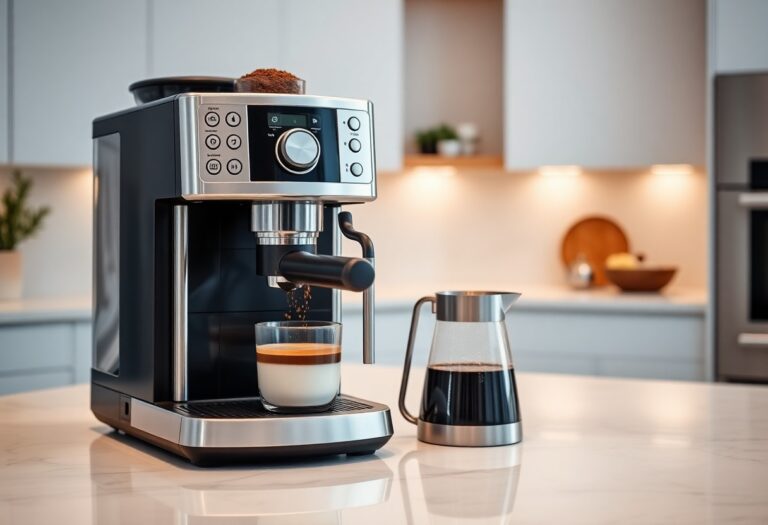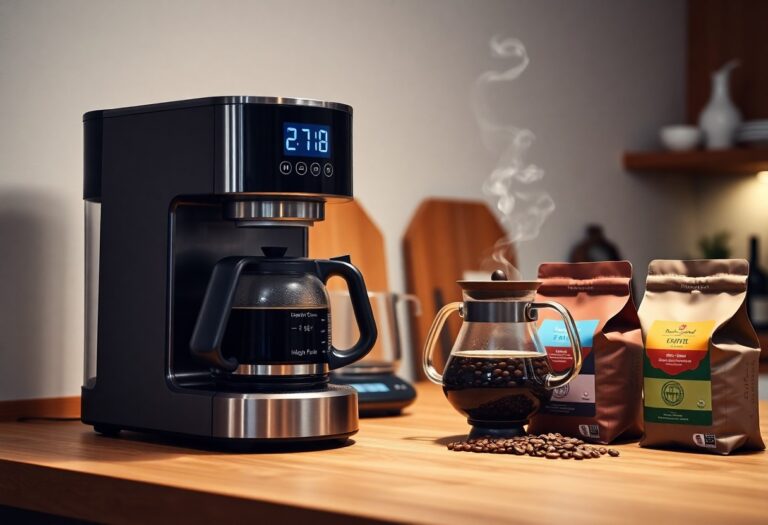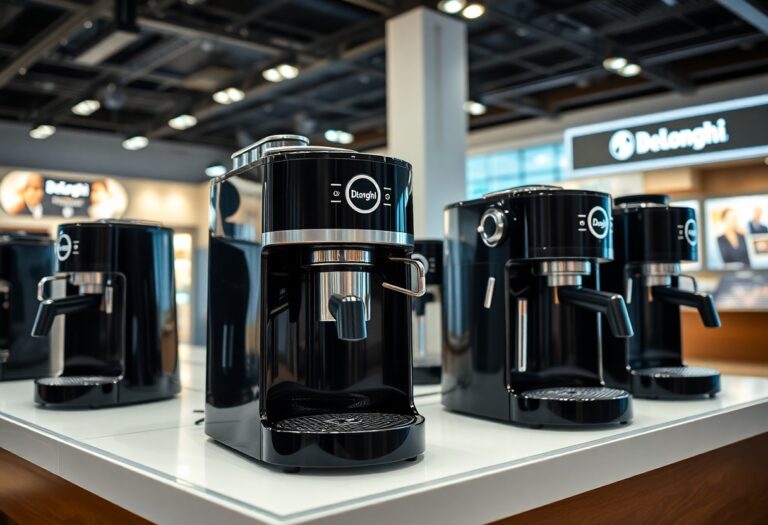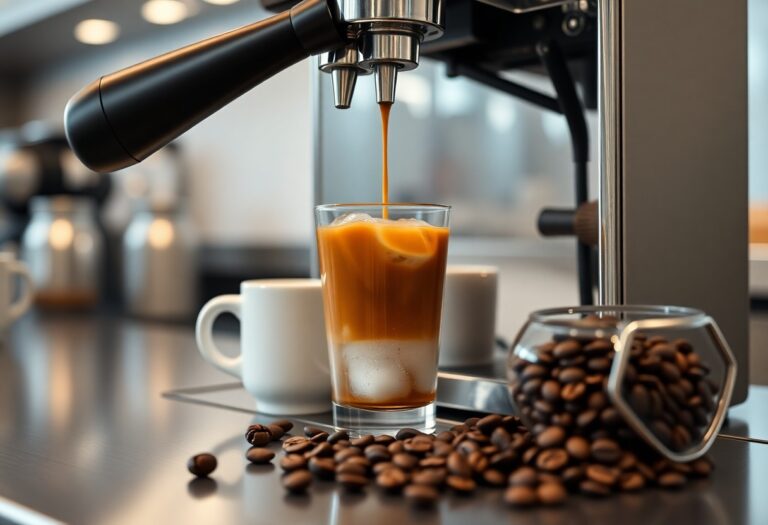What Coffee to Use in a Coffee Machine – Universal Guide
Over your coffee journey, you may have asked yourself what coffee to use in your coffee machine. The right choice significantly impacts the flavor and aroma of your brew, enhancing your overall experience. Freshly ground, high-quality coffee beans are vital for a delicious cup, while the grind size, roast level, and origin also play vital roles. This guide will equip you with the information you need to make informed choices for your perfect cup, ensuring that every sip delights your senses.
Key Takeaways:
- Choose coffee beans based on your preferred brew strength, flavor profile, and roast type to ensure a satisfying cup.
- Adjust grind size according to the coffee machine type; coarser for French press, medium for drip, and fine for espresso machines.
- Consider the freshness of coffee; opt for whole beans and grind just before brewing for optimal flavor.
- Experiment with different coffee origins and blends to discover unique taste experiences that cater to your palate.
- Pay attention to brewing temperature and time, as these factors can significantly influence the extraction quality and flavor of your coffee.
The Art and Science of Coffee Bean Selection
Selecting the right coffee bean is both an art and a science, requiring a keen understanding of flavor profiles, freshness, and processing methods. The nuances of bean origins, specific varietals, and even cultivation techniques play a significant role in how your coffee will taste. To achieve that perfect cup, consider factors like region, elevation, and even the soil type where the coffee was grown. Each element contributes to the complexity and richness of your brew, making your choice critical for enhancing your morning ritual.
Exploring Bean Varieties: Arabica vs. Robusta
Arabica and Robusta beans serve as the cornerstone of coffee culture, each boasting unique characteristics. Arabica beans are known for their smooth, nuanced flavors and aromatic qualities, often described as sweet and fruity. They thrive at higher elevations and make up about 60-70% of global coffee production. In contrast, Robusta beans tend to have a bolder, stronger taste with a hint of nuttiness. Typically grown at lower elevations, they contain double the caffeine content, making them a popular choice for espresso lovers due to their rich crema.
The Impact of Roast Levels on Flavor Profiles
The roast level dramatically influences the flavor profile of your coffee, impacting everything from acidity to sweetness. Lighter roasts typically preserve the beans’ original characteristics, allowing bright and fruity notes to shine through, while medium roasts strike a balance, offering a blend of acidity and body. Dark roasts tend to mask the bean’s unique flavors, producing a bold and robust cup with deep, toasty undertones. Understanding these nuances will guide your selection, helping you choose a roast that aligns with your taste preferences and brewing method.
The choice of roast level not only affects taste but also how caffeine and oils are released during brewing. Light roasts may have a higher acidity and are often favored for their vibrant flavor complexity, making them ideal for pour-over methods. Medium roasts provide a harmonious blend suitable for drip coffee makers, while dark roasts yield a bolder flavor that can hold up against milk and sweeteners, making them a favorite for lattes and cappuccinos. Given this, tailor your approach to match the roast with your specific brewing method for optimal results.

Grinding Grains: Timing and Techniques
Grinding your coffee beans properly can make a significant difference in the brewing process. Not only does the grind size affect extraction rates, but it also influences flavor clarity and aroma. To fully unlock the rich notes of your beans, consider factors such as grind size and freshness. If you want to learn more about the type of coffee used in a coffee-maker, check out this link on What Type of Coffee Is Used In a Coffee-Maker?
Coarse vs. Fine: Matching Grind Size to Brewing Method
Choosing the right grind size is important for optimal extraction. Coarse grinds work best for methods like French press or cold brew, where longer steep times are used. Conversely, fine grinds are ideal for espresso or AeroPress, where quick extraction is key. Ultimately, matching the grind size to your brewing method will enhance your coffee quality and flavor profile.
When to Grind: Freshness vs. Convenience
Grinding your coffee immediately before brewing ensures maximum freshness and flavor. Whole beans retain their aromatic compounds longer than pre-ground coffee, which begins to oxidize quickly. However, convenience factors may lead you to grind in advance. A practical solution is to grind slightly in advance, ideally no more than a week prior, while storing the ground coffee in an airtight container to preserve its integrity.
Incorporating a consistent grinding schedule helps balance your need for freshness with your daily routine. If you prefer grinding in batches, consider dividing your coffee into smaller portions to maintain freshness over time. Utilizing an airtight container will minimize exposure to air, humidity, and light, which can all degrade your coffee’s quality much faster. Regularly check on your stored coffee, and when possible, prioritize using freshly ground beans for a truly satisfying cup.
Brewing Methods and Their Coffee Compatibility
Your choice of brewing method influences the type of coffee you should use, as each method extracts different flavor profiles from the beans. Understanding how various brewing techniques interact with specific coffee types can greatly enhance your coffee experience. Factors such as grind size, water temperature, and brew time all play vital roles. For best results, align your coffee selection with the brewing method to achieve optimal flavor, aroma, and richness.
Drip Coffee Machines: Perfect Partners for Your Beans
For drip coffee machines, medium to medium-coarse grinds are ideal, allowing for even extraction during the brewing process. Beans that are less acidic and more robust, such as medium roasts, complement this method well, producing a smooth, well-balanced cup. When identifying your beans, look for blends that offer a rich mouthfeel and a consistent flavor profile that holds up during the typical brewing time of 4-6 minutes.
Espresso Machines: Choosing the Right Coffee for Bold Brews
Espresso machines require a different approach, where you’ll want to use finely ground beans to create a rich, concentrated shot of coffee. Dark roasts are often preferred, as they offer a bold and intense flavor that stands up well to the high pressure of espresso extraction. However, you can also experiment with light or medium roasts to discover unique flavor nuances, especially those with fruity or floral notes. Ultimately, the grind size, roast level, and bean origin will play a significant role in shaping your espresso’s taste.
Choosing the right coffee for your espresso machine involves considering not just the roast level, but also the origin and blend of the beans. Beans from regions like South America or Africa often provide distinct flavor characteristics. Espresso is best brewed at around 9 bars of pressure with water temperatures between 190°F and 205°F. This helps bring out the rich, aromatic oils present in the beans. Experimenting between single-origin coffees and blends can also yield fascinating results, enriching your overall espresso experience.
Water Quality: The Unsung Hero of Coffee Flavor
Your coffee’s flavor doesn’t solely rely on the beans; water quality plays a significant role as well. Clean, filtered water enhances extraction and allows the nuanced flavors of your coffee to shine. Contaminants or hard water can lead to undesirable tastes, affecting the overall experience of your cup. Aim for water that is free from impurities to create coffee with a rich, balanced flavor profile.
The Role of Mineral Content in Coffee Extraction
The mineral content of your water impacts how coffee compounds are extracted. Calcium, magnesium, and other minerals can positively contribute to flavor extraction, while excessive levels of chlorine or sodium may leave an unpleasant taste. Ideally, the total dissolved solids (TDS) in your water should be balanced to draw out the best flavor characteristics from your coffee beans.
Temperature and Its Effects on Brewing Quality
The brewing temperature can change extraction rates and overall flavor. The optimal temperature for most extraction ranges from 195°F to 205°F (90-96°C). Using water that’s too hot can lead to bitter flavors, while cooler water may under-extract, resulting in a weak and sour taste. Striking a balance ensures you enjoy the full spectrum of flavors your coffee has to offer.
Temperature Effects on Extraction
| Temperature Range (°F) | Flavor Outcome |
|---|---|
| Under 195°F | Sour, under-extracted |
| 195°F – 205°F | Optimal extraction, balanced flavor |
| Over 205°F | Bitter, over-extracted |
Finding the right temperature for your brewing process is imperative in controlling the flavor profile of your coffee. Keep in mind that factors like your specific beans and brewing method can also influence what you consider ‘optimal.’ Experimenting within the recommended range can reveal unique flavor potentials and enhance your overall coffee experience. Fine-tuning these variables can substantially elevate the quality of your brew, so don’t hesitate to invest time in getting it just right.
Temperature Effects on Extraction
| Temperature Range (°F) | Flavor Outcome |
|---|---|
| Under 195°F | Sour, under-extracted |
| 195°F – 205°F | Optimal extraction, balanced flavor |
| Over 205°F | Bitter, over-extracted |

Practical Tips for Coffee Lovers
To elevate your coffee experience, consider these practical tips tailored for passionate coffee lovers. First, invest in a high-quality burr grinder for consistent grind sizes. Choose premium beans based on your taste preferences and explore local roasters that offer freshly roasted options. Familiarize yourself with brewing techniques specific to your coffee machine, as this can significantly affect the extraction process. Lastly, pay attention to your water temperature for optimal flavor extraction. After implementing these strategies, you’ll notice a remarkable difference in every cup.
Experimentation: Finding Your Unique Flavor Profile
Exploring different coffee types and brewing methods allows you to uncover your unique flavor profile. Consider trying single-origin coffees with varying roast levels and tasting notes. Sample beans from various regions, such as fruity Ethiopian or rich Colombian blends. Track your brewing settings and results to identify which combinations resonate with your palate. As you experiment, you’ll refine your preferences and discover the coffee that truly excites you.
Storage Solutions to Preserve Coffee Freshness
The right storage solutions significantly determine how long your coffee beans remain fresh. Use an airtight container made of opaque materials to keep out light, moisture, and air. For longer shelf life, consider vacuum-sealed options or canisters with CO2 valves, which allow gases to escape without letting air in. Avoid storing coffee in the fridge or freezer, as fluctuations in temperature can negatively affect flavor. After you implement proper storage practices, your coffee will maintain its delightful taste and aroma for a longer period.
Prioritizing freshness and proper storage techniques can extend the life of your coffee beans considerably. For optimal results, choose a dark, cool place in your home to store your coffee, ideally away from heat sources like stoves or direct sunlight. Additionally, only buy what you can consume within a few weeks to ensure you’re regularly enjoying the freshest brew. Always grind your coffee just before brewing, as ground coffee loses flavor rapidly compared to whole beans. Adopting these habits protects your investment in quality coffee and enhances every cup you enjoy.
To wrap up
Presently, choosing the right coffee for your coffee machine significantly impacts your brewing experience and the flavors you enjoy. By considering bean type, grind size, and roast level, you can tailor your coffee choice to your preferences. Whether you opt for light, medium, or dark roasts, ensure that the coffee you select aligns with your taste profile and brewing method. With this universal guide, you’ll be equipped to make informed decisions that enhance your daily coffee ritual.
FAQ
Q: What type of coffee beans should I use in my coffee machine?
A: The type of coffee beans you choose depends largely on your personal preference. However, medium to dark roast beans are commonly recommended as they tend to yield a well-rounded flavor in various coffee machines. Arabica beans are generally favored for their smooth and complex flavor profiles, while Robusta beans can add a more robust, earthy taste. Always opt for fresh, whole beans and grind them just before brewing for the best flavor.
Q: Should I use pre-ground coffee or grind my own beans?
A: Grinding your own coffee beans allows for maximum freshness and flavor, as ground coffee begins to lose its imperative oils and aromas shortly after being ground. If you’re using a drip coffee maker, a medium grind is typically ideal, while espresso machines require a fine grind. For those who prefer convenience, quality pre-ground coffee can still produce excellent results, but it’s imperative to choose a brand that prioritizes freshness.
Q: How do I know what grind size is appropriate for my coffee machine?
A: The grind size can significantly affect the extraction process and flavor of your coffee. For drip coffee makers, a medium grind works best, while a French press calls for a coarse grind. Espresso machines, on the other hand, require a fine grind to create the necessary pressure during brewing. If you’re unsure, consult your coffee machine’s manual or experiment with different grind sizes until you find one that suits your taste.
Q: Are there specific brands of coffee that are recommended for coffee machines?
A: While brand preference can vary widely, several coffee brands are often recommended for their quality and variety. Brands such as Lavazza, Illy, Peet’s Coffee, and Stumptown are known for their carefully sourced beans and distinct flavors. Additionally, consider exploring local roasters for fresh, artisanal options. Your choice ultimately depends on your flavor preferences, so try a few different brands to discover what you enjoy most.
Q: How important is the water quality when brewing coffee?
A: Water quality is a significant factor in brewing coffee, as it makes up about 98% of the beverage. Use filtered or bottled water if your tap water has a strong taste or odor, as chlorine and other impurities can affect the flavor of your coffee. Additionally, hard water with high mineral content may lead to scaling in your coffee machine over time. Ideally, aim for water that is neutral in taste and free of impurities to enhance the overall coffee experience.







